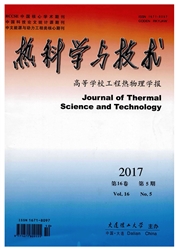

 中文摘要:
中文摘要:
通过实验验证了太阳池辐射透射模型(Wang and Seyed-Yagoobi model)在小浊度范围内的准确性,从光学和热力学角度分析了非均匀浊度下太阳池的辐射透射率,并模拟了不同浊度分布状况下太阳池储热层的温度及各层的热效率。当池水浊度在垂直方向上的平均浊度相同时,浊度分布自上而下线性递增情况时太阳池下对流层的辐射透射率、温度、热效率均高于浊度均匀分布和池水浊度分布自上而下线性递减两种情况。根据研究,指出了太阳池要着重控制上对流层和非对流层的浊度,而对于下对流层的浊度则不必重点处理。另外,对于实际的太阳池采取实验手段预防降雨对太阳池浊度产生的影响。
 英文摘要:
英文摘要:
Experiment results demonstrated that the W.S.model is effective at lower turbidities.The solar radiation transmission functions in different turbidities distributing through optics and thermodynamics was analyzed.Thermal performance of LCZ and thermal efficiency for each layer of a solar pond were simulated in different turbidities distributing.For three cases with equal average turbidity in vertical direction but different distribution,the solar radiation transmission functions,maximal temperature and thermal efficiency was the best in the case of turbidity increases linearly from the top downwards,better than the cases turbidity distribution uniformity and turbidity decreases linearly from the top downwards.It can be concluded that the turbidities of NCZ and UCZ should be controlled seriously and the turbidity reducing of the LCZ is not necessary.In addition,for the actual solar pond,measures should be taken to prevent rainfall from affecting the turbidity of the solar pond.
 同期刊论文项目
同期刊论文项目
 同项目期刊论文
同项目期刊论文
 期刊信息
期刊信息
